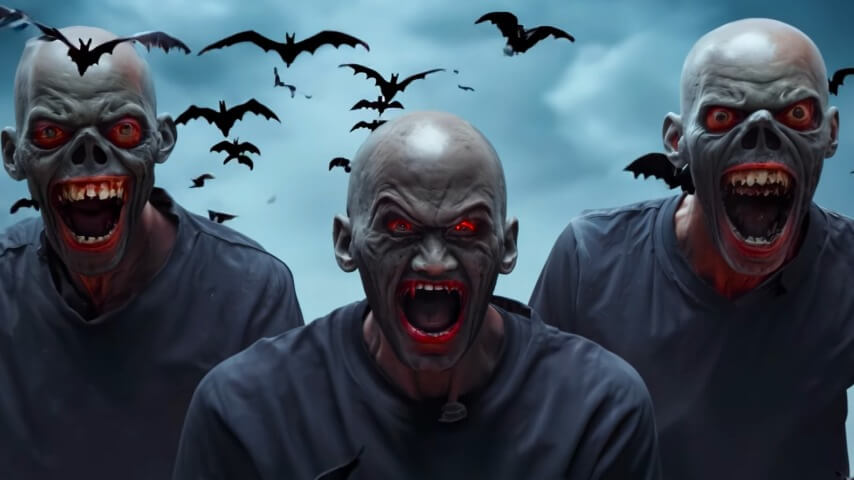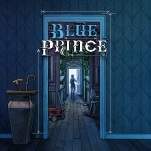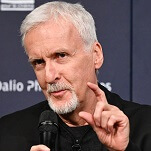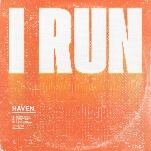Two films premiered during the 2025 fall festival season that used generative AI as part of their creative process. Neither director of these films is a cheerleader for the technology, at least not in the threatening, “you are replaceable” manner of Sam Altman-style AI evangelists. Instead, both take an agnostic stance, acknowledging the controversies and ethical issues surrounding generative AI while remaining optimistic about its potential as a democratizing force in filmmaking. Both were criticized, but only one of them—Todd Rohal’s Fuck My Son!—practically caused a riot at its premiere. By comparison, Radu Jude’s Dracula, which had its world premiere in August at the Locarno Film Festival, got off easy.
Like many of Jude’s movies, Dracula is divided into segments, one of which revolves around a lazy filmmaker (Adonis Tanța) introduced in his bathrobe sitting in a bare, monklike cell. He apologetically explains that he’s been charged with enhancing his new vampire movie with a pair of fictional Transylvanian AI software programs that have been fed pieces of iconic vampire media—the original cut “only” got an 80% approval rating at its most recent test screening, you see.
At various points throughout the film, Tanța interrupts the action to show us the fruits of this sloppy labor: A sequence “inspired” by Bram Stoker’s Dracula turns Coppola’s ravishing visuals into bizarre, melting shapes barely recognizable as pornography, while its Nosferatu riff is quickly overtaken by persistent, annoying internet pop-up ads. It’s all brazenly aesthetically offensive, and it feeds into Jude’s larger point about the slow breakdown of everything from Romanian history to the way we perceive reality itself.
Speaking with The A.V. Club—fittingly, with an AI-generated image of Donald Trump riding a giant kitten as his Zoom background—Jude says that he “was put off a bit when there were reviews [of Dracula] saying the film shows that AI is really bad and it’s a critique of AI,” he says. “I can see how it can be framed like that, but for me it was no critique. It was just another tool.”
“I am well aware of the economic problems and of the inequalities that [AI] creates, and think it needs a certain regulation in the end,” Jude adds. “But I don’t think it’s necessarily a bad thing. I think it can lead to interesting things, or even push cinema into different territories that [humanity] can do better than a machine.” His primary concern is that AI undermines the “supposed connection between an image and reality,” noting that, in 2025, “when you open [your] computer, the first thing you do when you see a photo is to ask yourself, ‘is it AI or is it a real photo?'”
But although he calls this ontological unmooring “scary”—Facebook, for example, is already being overrun with AI-generated images that spread misinformation, fueling the mistrust that’s currently undermining American democracy—Jude says he’ll continue to use generative AI in his work. He recently used an AI audio program to narrate a short film he made for the National Museum Of Cinema in Turin, Italy, and while he acknowledges that “somebody could say, an actress basically lost a job because she didn’t do this for the film…we’re on a Zoom, and someone could say, a plane company lost a seat because you didn’t travel…There should be a balance to all this. But while the technology exists, I feel like I have the right to use it.”
Jude adds that he sees a certain poetry in the images produced by these machines, which are sometimes “almost [like] an impressionist painting in a trashy, digital way.” Fuck My Son! director Todd Rohal, meanwhile, takes his art-history references a step farther: “When I started getting AI pushback, I thought about Marcel Duchamp and the urinal in the art museum,” he says. “I remember learning about that [as an art student] and how exciting it felt to read about an artist making something that caused a stir, that that caused anger. But it’s not a popular position to be in when it’s happening.”
In a phone interview with The A.V. Club, Rohal describes Fuck My Son! as “an exploitation movie,” one that’s designed to cause offense. (One could argue that, if you’re not offended by a movie called Fuck My Son!, then it’s a failure by its own standards.) Based on a story by alt-comics icon Johnny Ryan, the film is essentially a dirty joke told in slow motion as a woman (Tipper Newton) and her daughter are kidnapped from the parking lot of a strip mall and taken to the basement of an isolated farm house, where a Texas Chain Saw-esque matriarch commands the woman to sexually service her son—a drooling, flatulent, pustule-covered mutant in a prosthetic that makes Brendan Fraser’s fat suit in The Whale look tasteful.
But that’s not what upset audience members at the film’s midnight world premiere at the Toronto International Film Festival. TIFF Midnight Madness screenings are notoriously rowdy, and the crowd was more than sufficiently warmed up as the movie began. Then a sequence that was visibly rendered by generative AI—a fake ad parodying the self-aggrandizing reels that play before movies at major cinema chains—appeared on screen. The laughter stopped, the mood shifted, and the movie never really recovered. One Reddit thread called for the programmer who selected it to be fired.
The Letterboxd reviews coming out of that first screening were brutal, with the harshest critiques aimed at the film’s use of AI. “I wish I could say I’m smart, and I predicted all of this,” Rohal says. He adds that friends had warned him that “people are going to get mad at you,” but “I’m not on the internet much, so I couldn’t comprehend why any thinking person could watch a movie like this and become upset about what they have been upset about.”
Rohal’s beef is with Hollywood. “We’ve had movies that look like shit for the last twentysomething years. When you pitch a movie or a TV show at a studio, they want to know what they’re getting before they get it, so you tell them it’s going to look like something that already exists,” Rohal says. “My film does not use AI in a way that advances things aesthetically, because that’s just not the nature of this film. But I’m shocked at people defending Hollywood movies as if we’re in the middle of some renaissance that AI is going to destroy.”
Rohal’s other major AI gambit in Fuck My Son! involved the creation of the Meatie Mates, a friendly gang of drippy, turgid meat products who star in a popular in-universe children’s cartoon. Adults who spend a lot of time around Generation Alpha might recognize the Meatie Mates as the perverse cousins of Italian Brainrot characters like Tung Tung Tung Sahur and Ballerina Cappuccina. Rohal didn’t know about any of that when he started working on Fuck My Son! (The trend didn’t exist yet.) Rohal was just making fun of Veggie Tales, a now-formerly-Christian kids’ cartoon whose characters don’t have arms or legs, in part because they would be too expensive and time-consuming to animate.
Rohal says he spent “months” adding mouth syncing and compositing the Meatie Mates together by himself, by hand. “I have the kidney stones to prove it,” he jokes, estimating that “30% [of the Meatie Mates animation] was AI, and then the rest of it was traditional digital compositing with After Effects.” Both he and Jude modified the generative AI sequences in their films, for practical reasons, artistic reasons, or both. It reflects one point on which the directors are in total agreement: Both think of AI as a tool artists can use to expand what they can do creatively, not as a threat to human creativity itself.
“I come from a country where there’s no industry really, and where the stakes are low from a financial point of view. Our whole industry is a few million dollars, it’s like the catering for a Hollywood movie,” Jude says, noting that discussions about AI in his circles in Romania are more theoretical than the ones happening in Hollywood. “There’s nothing to lose in a certain way.” He adds that, originally, his plan for Dracula was “to pretend, for narrative purposes, that there’s an AI machine generating [the] stories,” while creating the visuals through traditional means. Then a chunk of the film’s financing fell through; determined to get the movie done that year, Jude decided to actually use AI.
Like Jude, Rohal is working so far outside of the system that he feels he has nothing to lose. “It might be unpopular, but I really see it as a tool that can democratize film, truly. That scares millionaires, and I love work that scares the shit out of millionaires,” he adds.
In fact, Rohal is doubling down, adding AI trailers to the roadshow version of Fuck My Son! that were made by Damon Packard, creator of the (in)famous piece of psychedelic outsider art Reflections Of Evil. Packard has pivoted to making films entirely with AI, which Rohal calls “a complete extension of what he’s always been doing and how he makes movies…Being an absolutist about AI makes no sense [to me]. It just doesn’t apply on every scale. If I have $1,000 I could give to an artist that I love, I don’t care what medium he’s using.”
These filmmakers’ stances on generative AI deviate significantly from mainstream opinion in Hollywood, where the technology is widely derided as “theft machines” that serve no purpose other than depriving creatives of both money and credit for their work and likenesses. In 2023, the WGA added protections to its latest contract that require studios to disclose when scripts are wholly or partially AI generated, and mandate that members cannot be fired for refusing to use AI at work. An AI cannot be a credited writer on a WGA project, and studios cannot ask members to rewrite AI-generated materials. (There are still no protections against studios using scripts they already own to train AI models.)
The use of AI to replicate human performances was also a major sticking point in recent negotiations between video game companies and SAG-AFTRA, and the union plans to ask for protections against actors’ likenesses being used without their permission by generative AI programs when the TV/Theatrical division’s contracts come up for renewal in 2026. Two major points that arise again and again in these negotiations are compensation and consent. Financially speaking, Dracula and Fuck My Son! were made so far outside of the system that the compensation point is effectively irrelevant. But the question of consent might explain why the initial backlash against Rohal’s film was more dramatic than that against Jude’s.
When talking about the ethics of generative AI, Jude is a bit more measured than Rohal. And he’s more explicit in the way he frames the generative AI in Dracula. The technology is baked into the concept, so no one can say they were blindsided by its use in the film; just to be sure, however, Jude has an actor set the audience up for what they’re about to see. And critics, on the whole, have given Dracula the benefit of the doubt in terms of satire, acknowledging that, while they might not agree with Jude’s use of the technology, they understand that there’s a point and a purpose behind it.
By comparison, Fuck My Son! unleashes its generative AI sequences on the viewer without any warning, assuming that they’ll understand that they’re part of a larger, proudly offensive joke. And while Rohal has a point when he says that he can’t believe that “this is the thing people are upset about” in an X-rated movie that revels in perversion and provocation, each passing shock-value moment makes it a little less likely that an audience member might be inclined to let the whole AI thing go. And, at least at that initial screening, they did not let it go.
If nothing else, Dracula and Fuck My Son! are a case study in the difference between an art film and an exploitation film, in packaging and presentation as well as in content. Dracula is being framed as an art film, screening for sophisticated audiences at more intellectually-minded festivals; Fuck My Son! is a midnight movie, playing to viewers who consider themselves part of a community, not just an audience. This dichotomy isn’t one necessarily assigned by the filmmakers; Jude says that “one of my models is Roger Corman, who used to use whatever he had around in order to finish a film. I’m sure Roger Corman would have used AI with no shame.”
But it’s impossible to blame the audiences. In North America, at least, all we ever hear about artists and generative AI is from hostile tech types who take no small joy in announcing that hey, artists might think they’re better than us now, but they won’t be so smug when we’ve automated them out of existence. A sneering contempt for community, hard work, and passion aside—something that those against AI oppose as much as the technology’s environmental impact and built-in tendency towards plagiarism—big tech also has a financial interest in making us believe that AI is unavoidable. They have a product to push.
The sociopolitical context of generative AI is difficult to put aside, as it should be. We all have a right to be angry about one more bullshit late-capitalist scheme to suck the joy out of human existence in favor of increasing productivity for shareholders who won’t even notice the soul-crushing sacrifices we’re making on their behalf. (For a great film about this exhaustion, one might watch Radu Jude’s Do Not Expect Too Much From The End Of The World.) But on the edges of these debates, outsiders like Radu Jude and Todd Rohal are experimenting with different modes of working with AI, ones that put human artists at the center of the equation instead of writing them out.
For his part, Rohal says that, even if he could make films entirely on his own with AI, he wouldn’t. “I will always collaborate” with other humans, he says. “Anyone that’s made something knows that your idea is the baseline, and then it just gets better with collaboration.” But, as controversial as it might be, he wants to keep working with generative AI technology in his films. “I’m almost 50 years old,” he says. “And to feel passion come back into a thing that I felt there was no passion in anymore…I can’t then say, ‘AI is shit.'”









































